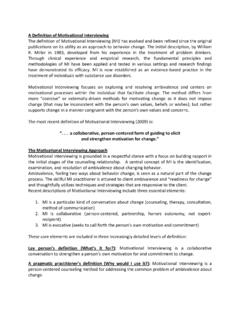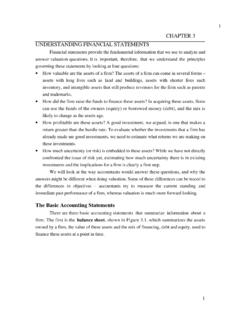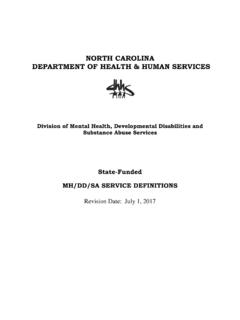Transcription of Seven Principles of the Constitution - NBISD
1 244 THELIVINGCONSTITUTIONS even Principles of the ConstitutionThe Framers of the Constitution constructed a new system of Principles supported their efforts. To picture how these principleswork, imagine Seven building blocks. Together they form the foundation of the United States Constitution . In the pages that follow, you will findthe definitions and main ideas of the Principles shown in the SovereigntyWho Gives the Government Its Power? We the people of the United States ..establish this Constitution for the United States of America. These words from the Preamble,or introduction, to the Constitution clearly spell out the source of the government s power. TheAmerican form of government comes from a schoolof political thought called classical liberalism, whichemphasizes freedom, democracy, and the importanceof the individual. The Constitution rests on the ideaof popular sovereignty a government in which thepeople rule. As the nation changed and grew, popu-lar sovereignty took on new meaning.
2 A broader range of Americans shared in the power to govern 1987, Americans gathered in Washington, ,to celebrate the 200th anniversary of theConstitution. The banner proudly displays that the power to govern belongs to the andBalancesRepublicanismSeparation of PowersLimitedGovernmentUNITED STATESCONSTITUTIONI ndividual Rights CALIFORNIA the nation's blendof civic republicanism, classical lib-eral Principles , and English parlia-mentary the Principles offederalism, dual sovereignty, sepa-ration of powers, checks and bal-ances, the nature and purpose ofmajority rule, and the ways inwhich the American idea of con-stitutionalism preserves Handbook24522 RepublicanismHow Are People s Views Represented in Government?The Framers of the Constitution wanted the people tohave a voice in government. Yet the Framers also fearedthat public opinion might stand in the way of sound decision making. To solve this problem, they looked torepublicanism as a model of based on this belief: The people exer-cise their power by voting for their political to the Framers, these lawmakers played the keyrole in making a republican government work.
3 Article 4,Section 4, of the Constitution also calls for every state tohave a republican form of government. CivicRepublicanism is the idea that citizens stay informedabout politics and participate in the a republican government, votingcitizens make their voices heard at thepolls. The power of the ballot promptscandidates to listen to people s Is Power Shared?The Framers wanted the states and the nation to become partners in governing. To buildcooperation, the Framers turned to a system of government in whichpower is divided between a central governmentand smaller political units, such as states. In theearly years of the United States, federalism wasclosely related to dual sovereignty,the idea that thepowers of the federal government and the stateswere clearly defined, and each had exclusive powerover their own spheres with little overlap. Thisview of federalism led to states rights conflicts,which were contributing factors in the Civil Framers used federalism to structurethe Constitution .
4 The Constitution assignscertain powers to the national are delegated kept by thestates are reserved shared orexercised by national and state governmentsare known as concurrent overlapping spheres of powerbind the American people Reserved for the State GovernmentsPowersDelegated to the NationalGovernmentShared(Concurrent)Powe rs ConstitutionHANDBOOK246 THELIVINGCONSTITUTION4455 Checks and BalancesHow Is Power Evenly Distributed?Baron de Montesquieu, an 18th-century Frenchthinker, wrote, Power should be a check to power. His comment refers to the principle of checks branch of government can exercisechecks, or controls, over the other branches. Thoughthe branches of government are separate, they rely onone another to perform the work of Framers included a system of checks and balances in the Constitution to help make sure thatthe branches work together fairly. For example, onlyCongress can pass laws. Yet the president can checkthis power by refusing to sign a law into action.
5 Inturn, the Supreme Court can declare that a law,passed by Congress and signed by the president,violates the of PowersUNITED STATES CONSTITUTIONA rticle 1 Legislative BranchCongress makes the 2 Executive BranchPresident enforcesthe 3 Judicial BranchSupreme Court interprets the of PowersHow Is Power Divided?The Framers were concerned that too much power might fall into thehands of a single group. To avoid this problem, they built the idea ofseparation of powersinto the Constitution . This principle means thedivision of basic government roles into branches. No one branch isgiven all the power. Articles 1, 2, and 3 of the Constitution detail howpowers are split among the three Branch(Congress)Judicial Branch(Supreme Court)Executive Branch(President) the Principles offederalism, dual sovereignty, sepa-ration of powers, checks and bal-ances, the nature and purpose ofmajority rule, and the ways inwhich the American idea of con-stitutionalism preserves STANDARDS6677 Individual RightsHow Are Personal Freedoms Protected?
6 The first ten amendments to the Constitution shield people from an overly powerful government. Theseamendments are called the Bill of Rights. The Bill ofRights guarantees certain individual rights,or personalliberties and privileges. For example, government cannotcontrol what people write or say. People also have the right to meet peacefully and to ask the government to correct a problem. Later amendments to the Constitutionalso advanced the cause of individual GovernmentHow Is Abuse of Power Prevented?The Framers restricted the power of 1, Section 9, of the Constitution lists thepowers denied to the Congress. Article 1, Section 10,forbids the states to take certain principle of limited governmentis alsoclosely related to the rule of law : In the Americangovernment everyone, citizens and powerful leadersalike, must obey the law. Individuals or groups cannot twist or bypass the law to serve their own exercise their right to urge the community to protect Handbook2471.
7 Main are the Seven Principles of government?( ) does the Constitution reflect the principle of separation of powers? ( ) did the Framers include a system of checks andbalances in the Constitution ? ( )2. Critical ThinkingForming OpinionsHow do the rights and responsi-bilities of citizenship reflect American nationalidentity? ( )THINK ABOUT what it means to be an American the rights and responsibilities of citizensAssessment: Principles of the Constitution In this political cartoon, President RichardNixon shakes his fist as he defies the ruleof law. Faced with charges of violatingthe Constitution , Nixon resigned aspresident in


